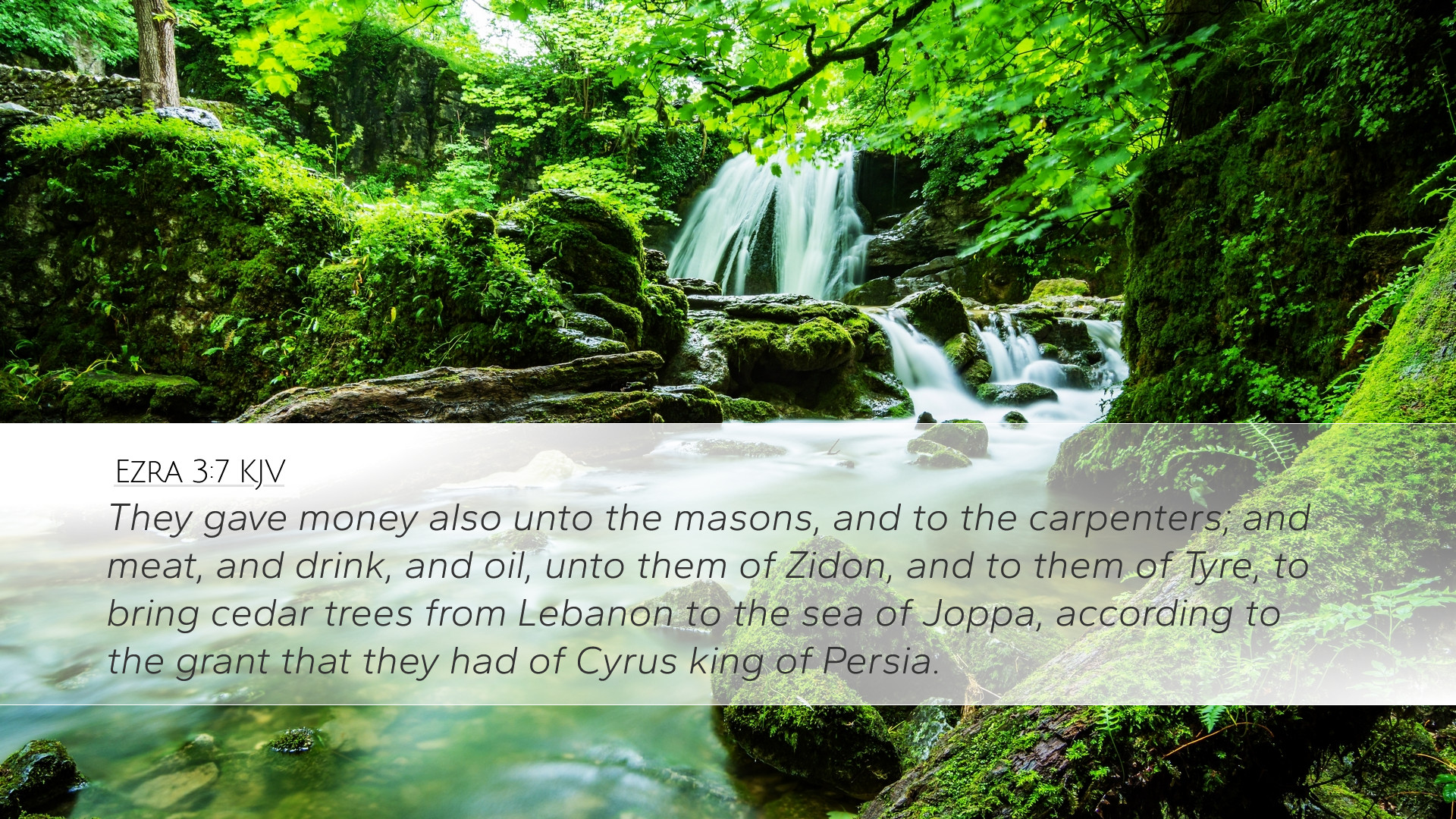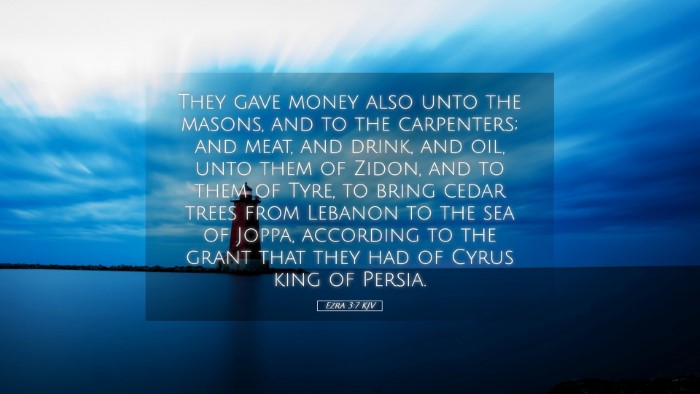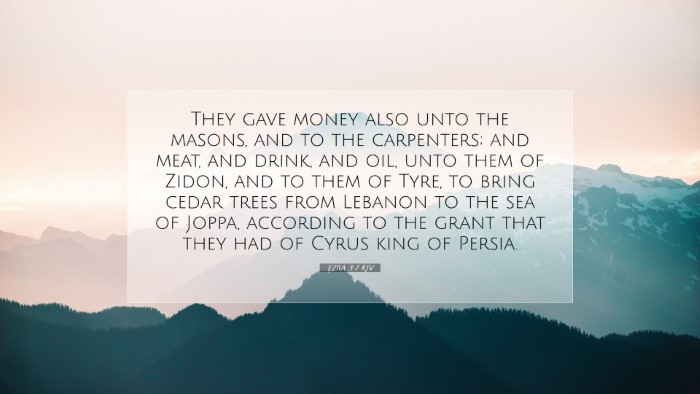Old Testament
Genesis Exodus Leviticus Numbers Deuteronomy Joshua Judges Ruth 1 Samuel 2 Samuel 1 Kings 2 Kings 1 Chronicles 2 Chronicles Ezra Nehemiah Esther Job Psalms Proverbs Ecclesiastes Song of Solomon Isaiah Jeremiah Lamentations Ezekiel Daniel Hosea Joel Amos Obadiah Jonah Micah Nahum Habakkuk Zephaniah Haggai Zechariah MalachiEzra 3:7
Ezra 3:7 KJV
They gave money also unto the masons, and to the carpenters; and meat, and drink, and oil, unto them of Zidon, and to them of Tyre, to bring cedar trees from Lebanon to the sea of Joppa, according to the grant that they had of Cyrus king of Persia.
Ezra 3:7 Bible Commentary
Ezra 3:7 - Commentary Summary
Ezra 3:7 states: "They gave money also unto the masons, and to the carpenters; and meat, and drink, and oil, unto them of Zidon, and to them of Tyre, to bring cedar trees from Lebanon to the sea of Joppa, according to the grant that they had of Cyrus king of Persia."
Introduction
This verse marks a significant moment in the history of the Jewish people as they return to their homeland after the Babylonian exile. It highlights their commitment to rebuilding the temple in Jerusalem, not only as a place of worship but as a central aspect of their identity as God’s chosen people.
Historical Context
Following the decree of Cyrus king of Persia, the Israelites were allowed to return to Jerusalem. This act was not only a political move but also a divine intervention fulfilling the prophecies concerning the restoration of Jerusalem.
Insights from Commentators
Matthew Henry
Henry emphasizes the unity and collective effort of the Israelites in this rebuilding project. He notes that the returning exiles, despite their brief and precarious situation, mobilized their resources to secure materials for the construction. The involvement of the neighboring nations, specifically the Sidonians and Tyrians, signals a restoration of commerce and diplomacy in the region.
Albert Barnes
Barnes elaborates on the specifics of the resources that were gathered. He explains that using masons and carpenters indicates a careful approach to craftsmanship and attention to detail in rebuilding the temple. He also highlights the importance of the materials sourced from Lebanon, illustrating their quality and the historical significance of Lebanon as a region known for its cedar trees, a symbol of strength and durability.
Adam Clarke
Clarke provides theological insights about the significance of gathering materials for the temple. He posits that the temple represents the dwelling place of God among His people and that the effort put into its rebuilding reflects their desire for God’s presence once again in their midst. He notes the generosity exhibited by the Israelites in their contributions, which serves as a model for sacrificial giving in the service of God.
Theological Reflections
This verse prompts reflections on several key theological themes:
- Restoration: The act of gathering materials for the temple signifies a broader restoration of the covenant relationship between God and His people.
- Collaboration: The collective effort illustrates the necessity of unity among believers in the pursuit of God’s work.
- Divine Provision: The involvement of foreign nations in the supply of materials demonstrates God’s ability to provide through unexpected means.
- The Importance of Worship: The temple is central to Israel's worship and identity, emphasizing the need for a dedicated place for communal worship.
Practical Application
For pastors, students, theologians, and Bible scholars, Ezra 3:7 serves as a reminder of the importance of laying a strong foundation for spiritual endeavors. Here are practical applications derived from this verse:
- Encouraging Generosity: Leaders can use this example to inspire generosity within their congregations for church projects and mission work.
- Fostering Unity: Highlight the necessity of working together toward a common goal within the church community.
- Recognizing God’s Provision: Encourage reflection on how God works through various means to support the church’s mission.
- Valuing the Sacred Space: Promote reverence for places of worship as crucial to the communal and individual experience of faith.
Conclusion
Ezra 3:7 encapsulates a critical juncture in Israel's history that underscores themes of restoration, collaboration, and divine provision. Through the efforts of the returning exiles to gather materials for the temple, we see a picture of obedience, commitment, and the collective spirit necessary for rebuilding not just a physical structure but the very heart of their worship. This verse challenges contemporary believers to consider how they contribute to the foundations of faith within their communities and the broader mission of the church.


